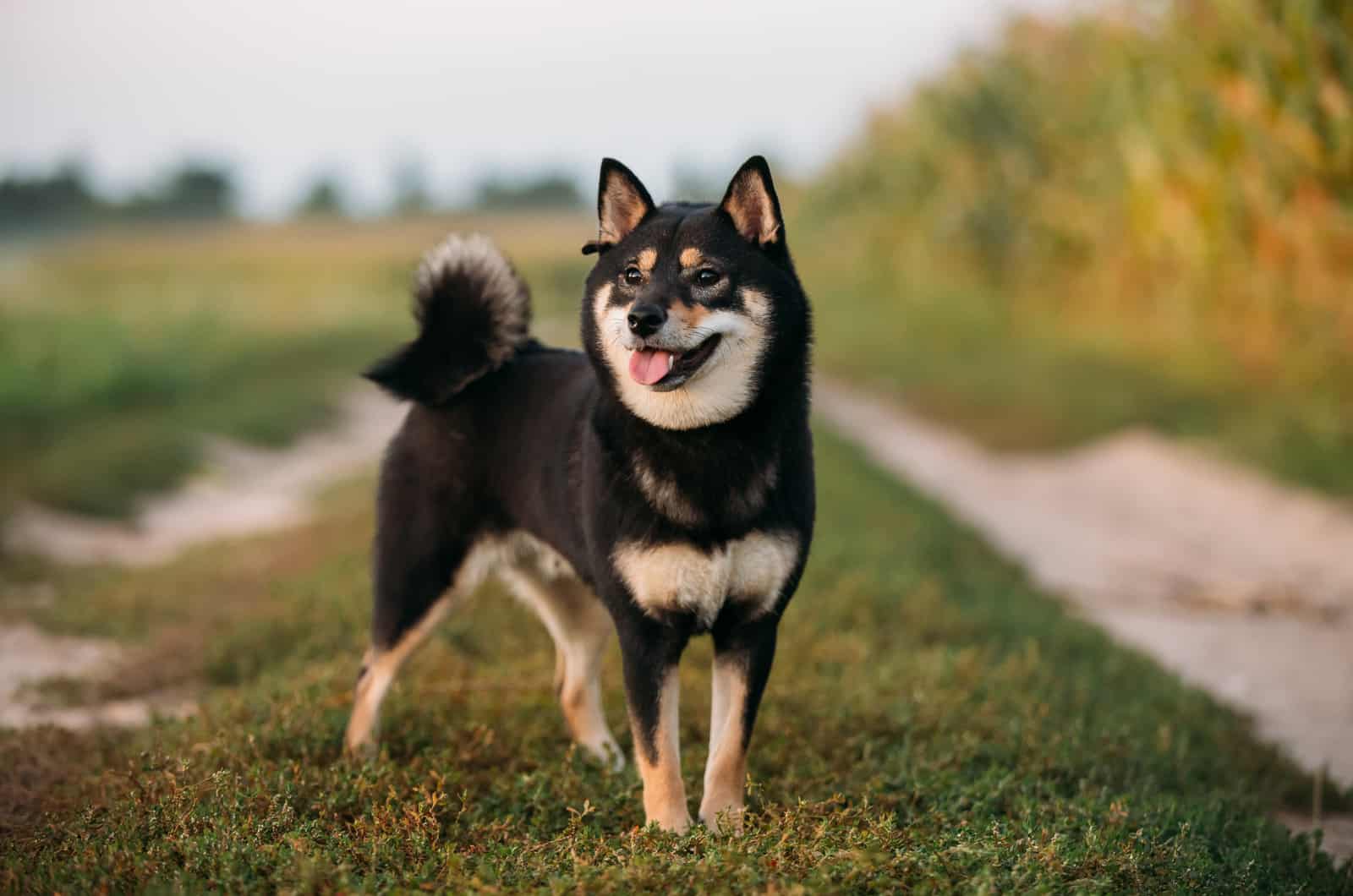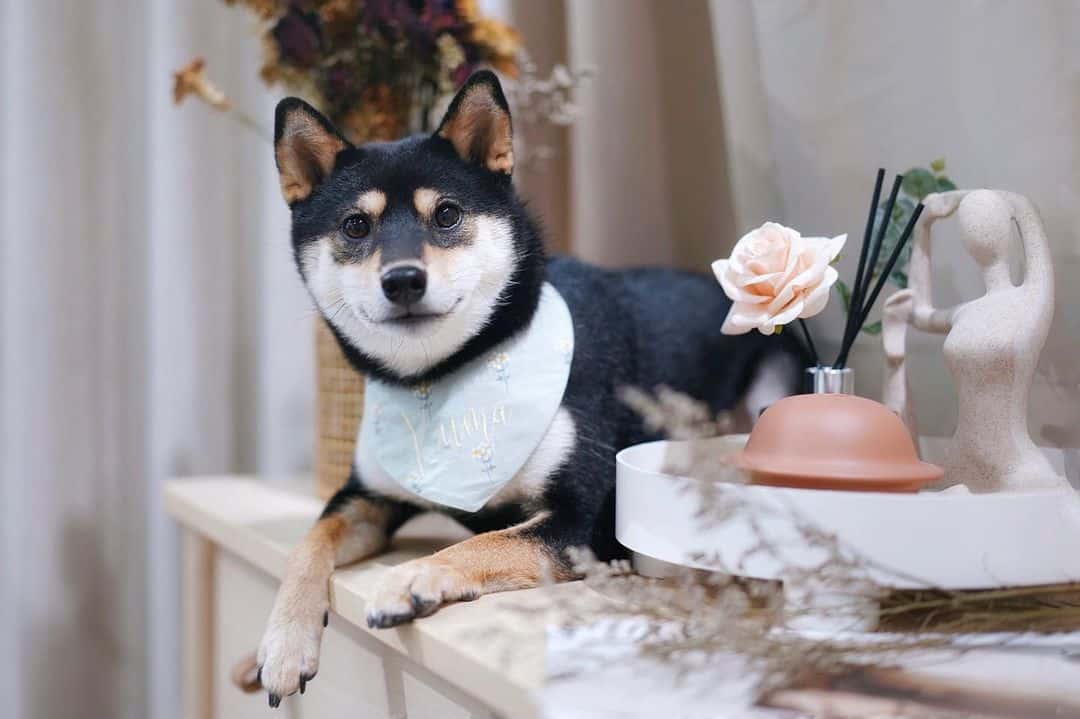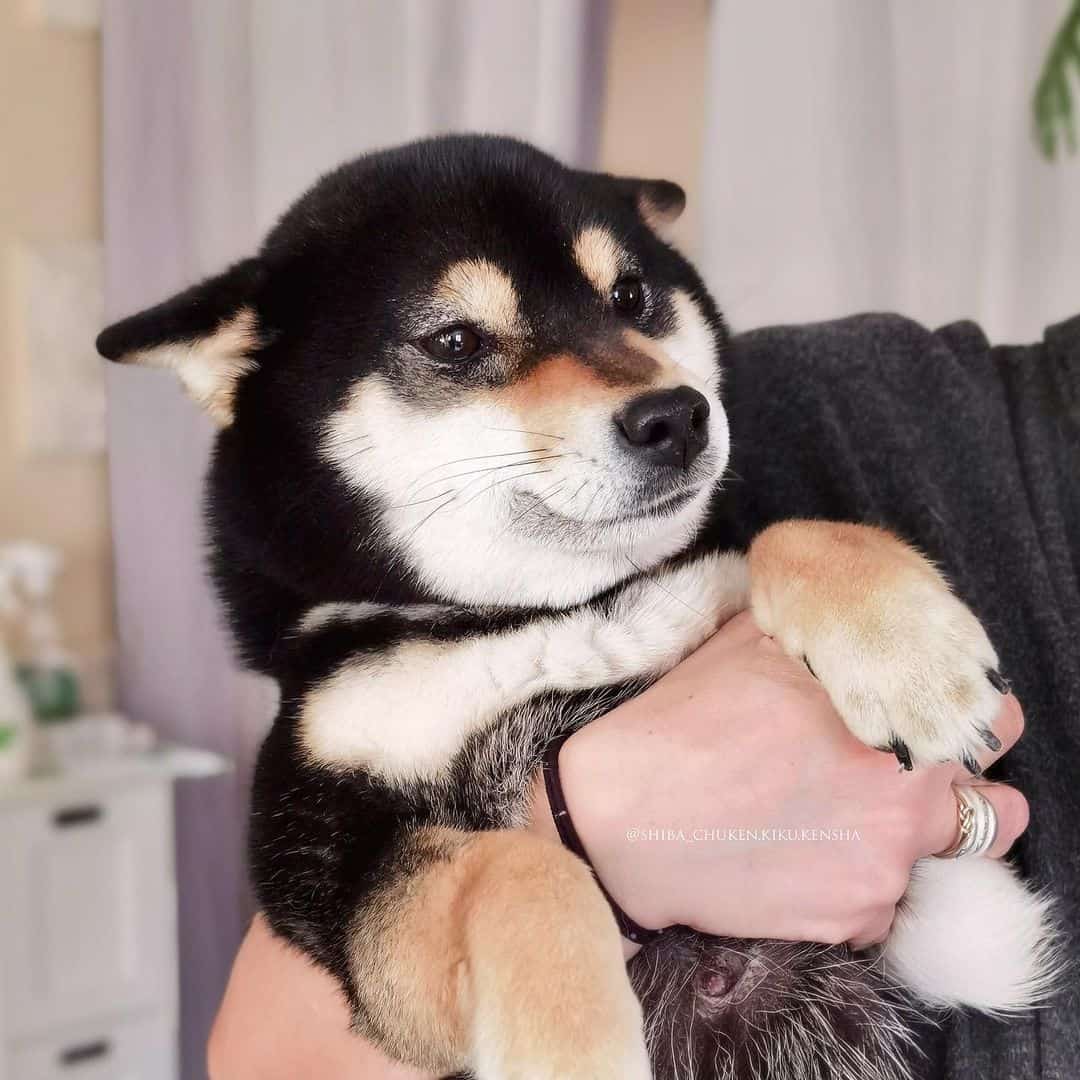Here’s a newsflash: there’s no such thing as a black Shiba Inu, which presents a slight hitch if you did want to buy one!
However, an article that’s only one sentence long isn’t really much use to anyone, so we’ll soldier on and try to provide you with some helpful information about the wonderful, fox-like Shiba Inu and its coat colors.
So, what would you like to know?
There’s a good chance that by now, you’re thinking, but I’ve seen black Shiba Inus on the internet!
In which case, we’ll begin with an explanation.
Black Sesame Shiba Inu
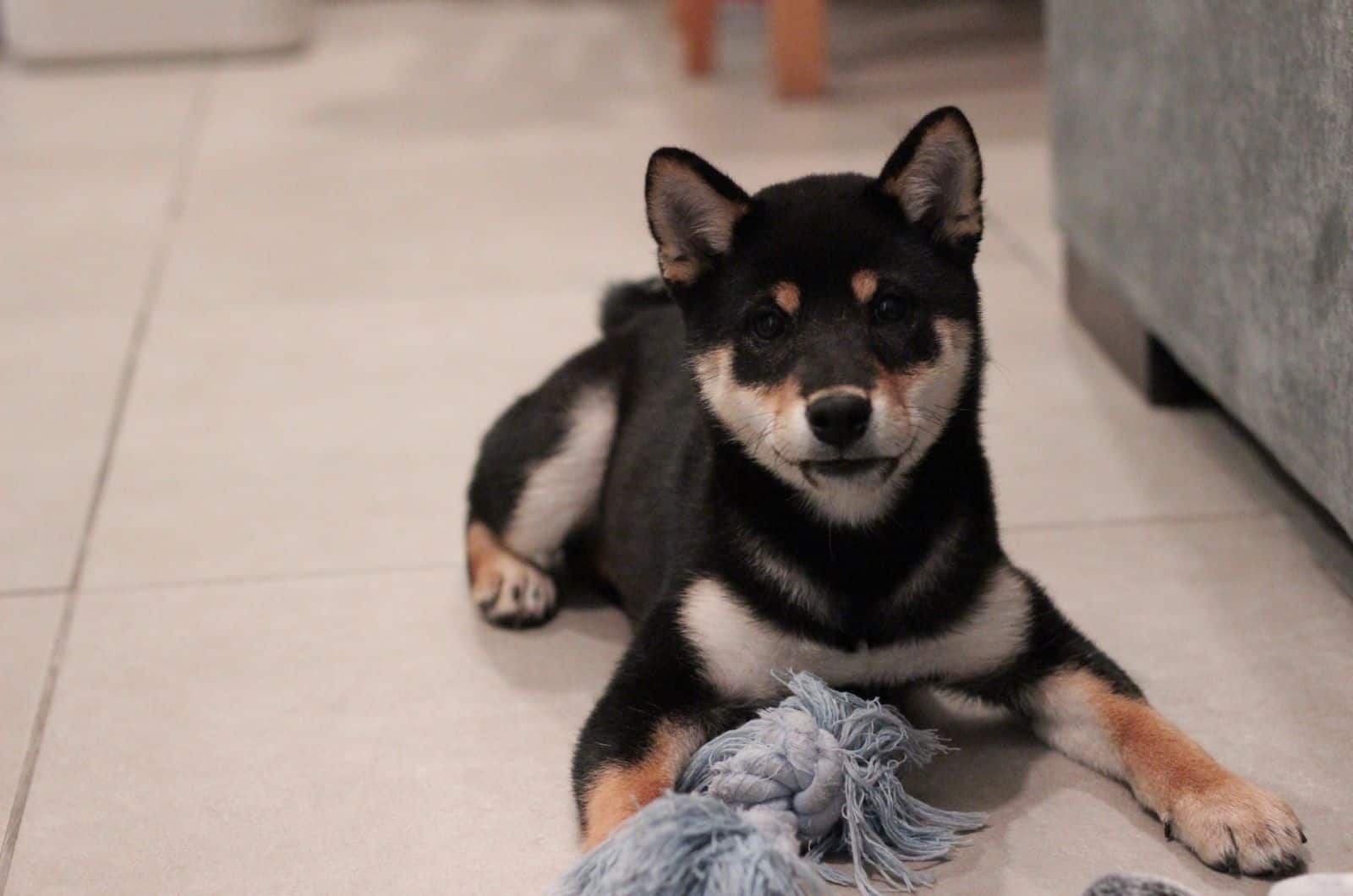
When dog owners talk about their black Shiba Inus, they mean the black sesame, or maybe even the black and tan version (see the next section).
Black sesame Shiba Inus are, admittedly, sometimes mostly black, although they do have white markings on their chest, cheeks, and tail, traditionally known as urajiro (literally meaning white underside). The black coat covers them in a similar fashion to the German Shepherd, with its ‘saddle’ pattern.
They are not considered solid black, which is what many of us think when we imagine a black dog.
These dogs still have a red base coat (which we’ll cover in more detail in the red sesame section), but with a black overtone. If you examined a single hair on a black sesame Shiba Inu, you might see three separate bands of color.
To qualify as a black sesame color, the dog can have no more than 50% black in its coat.
This coat color is not recognized in the breed standards of many official organizations, such as the American Kennel Club (AKC).
Shiba Inu; Black And Tan
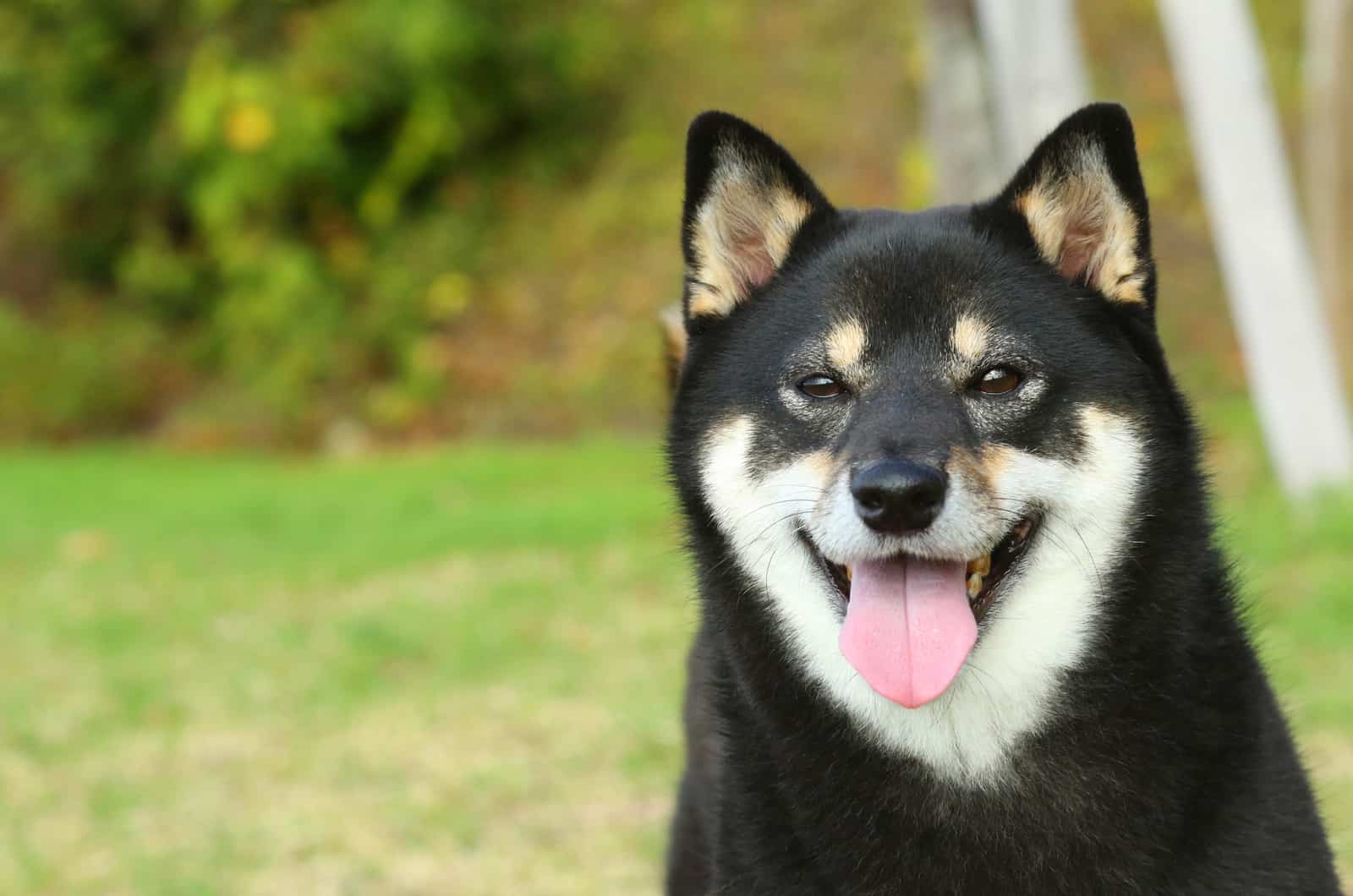
Also referred to as the black Shiba Inu, the black and tan Shiba Inu is recognized in the official breed standards of the AKC.
As well as calling these dogs black Shiba Inus, some people also refer to them as black and white, which isn’t at all helpful!
They usually have some white on them in the form of the traditional Japanese urajiro markings, but they will also have tan points, making them a tricolor dog, in effect.
But, it isn’t a black dog, nor is it black and white.
The Japanese Shiba Inu
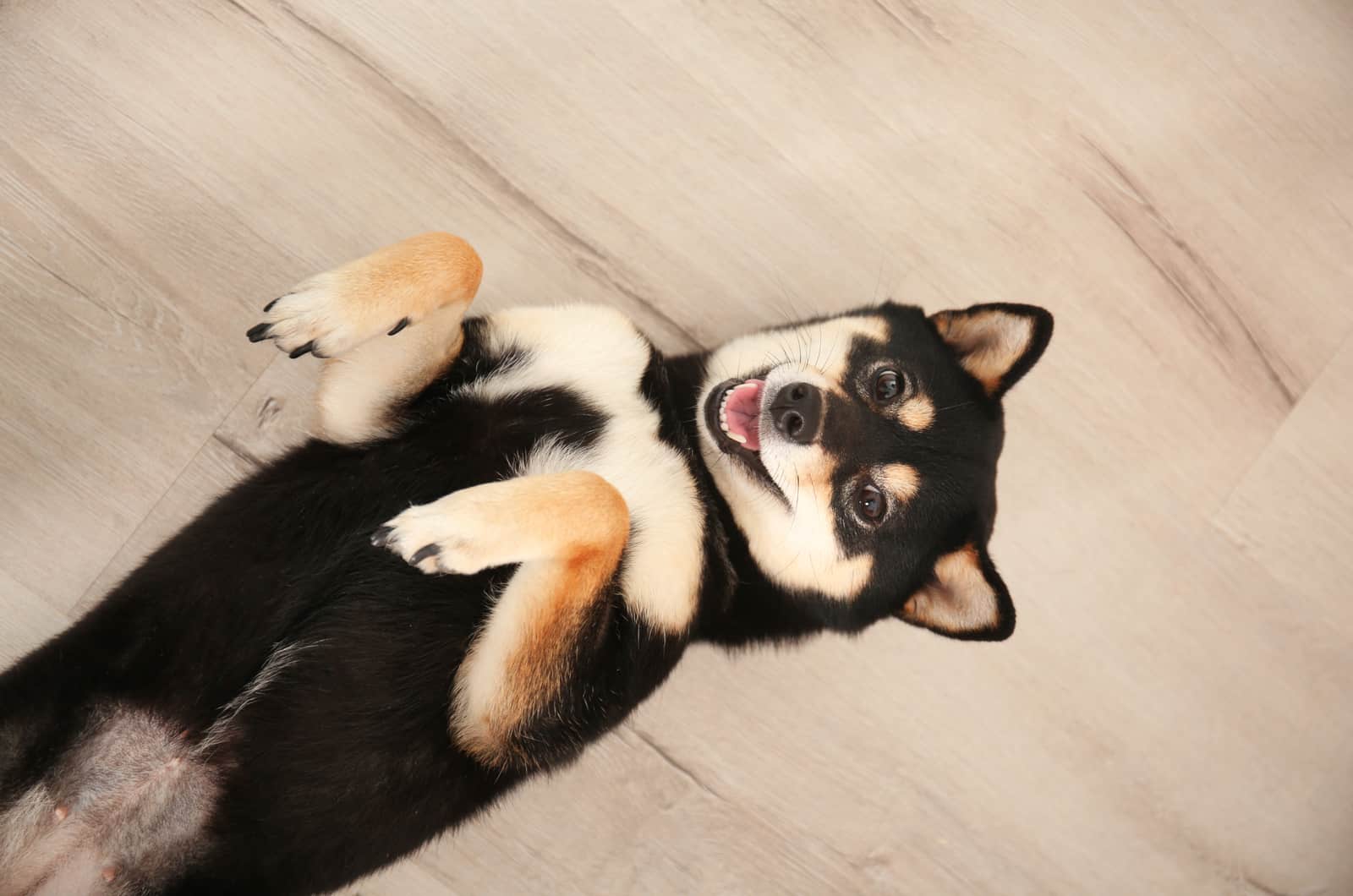
We’re taking a few moments here to fill in some gaps about these cute, affectionate, energetic little dogs just to give a fuller picture of the breed.
They have a short double coat that sheds a lot (get ready with the brush and vacuum cleaner!). The outer coat is stiff and straight, but silky like the Siberian Husky coat, though the two breeds are not related.
Males weigh no more than 23 pounds, while females don’t usually get any heavier than 17 pounds.
Females are also shorter, measuring between 13.5 to 15.5 inches at the shoulder, and males stand between 14.5 and 16.5 inches.
They are bold, fearless, and confident, with muscular, athletic bodies. Their shape and color frequently cause people to ask their owners if they have a pet fox!
Other Shiba Inu Coat Colors
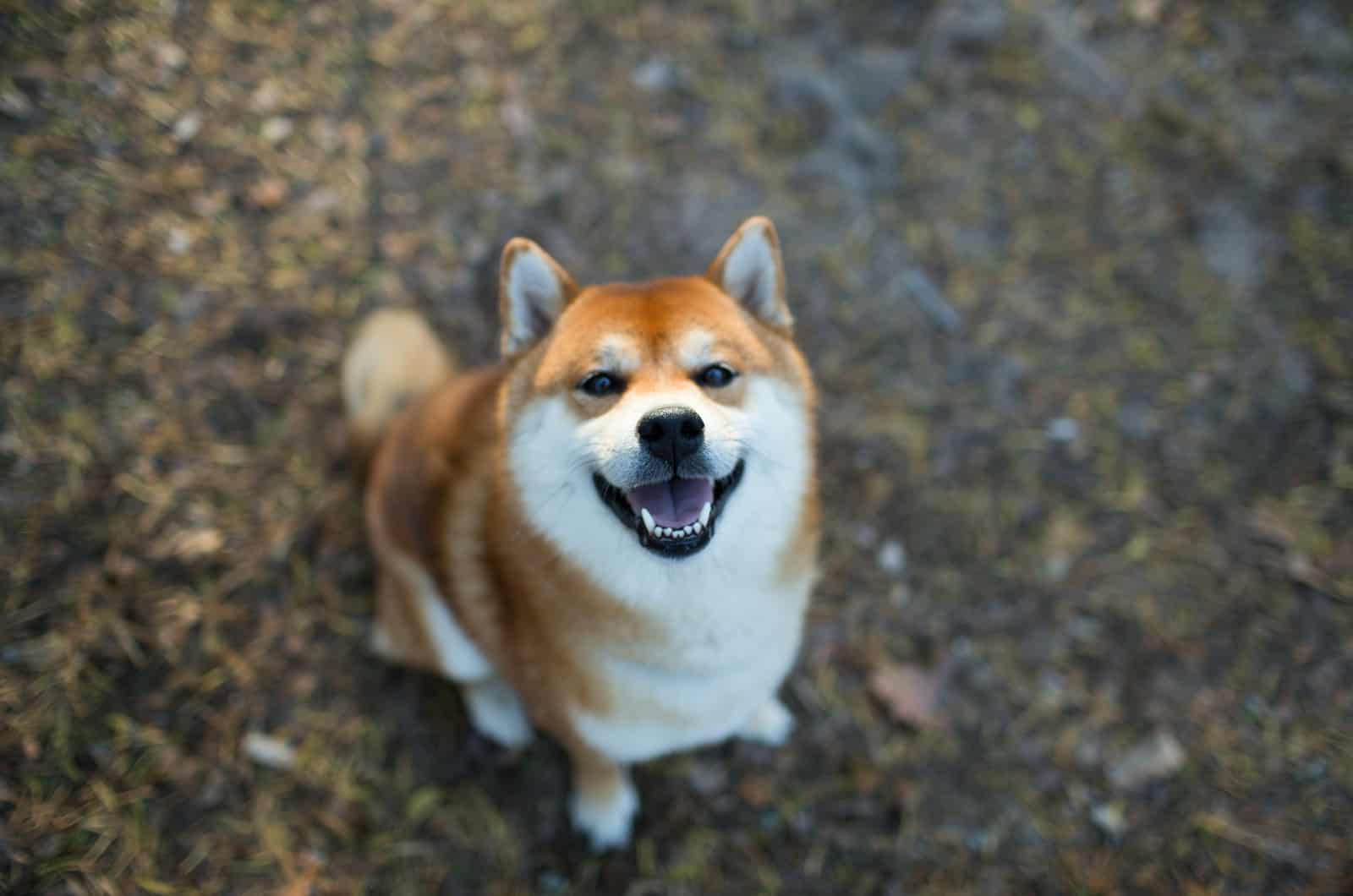
We know that the black Shiba Inu doesn’t exist, and that people use this name to describe the black and tan dog as well as the black sesame Shiba. But, what about the other colors?
Well, there’s the red Shiba Inu, which is the most popular coat color, along with the red sesame, and the cream-colored Shiba.
Red sesame is similar to the red Shiba, but with black tips on the hairs. It’s a stunning combination, especially as the shades can vary. This results in a whole range of fascinating effects. When the black tipping is extensive, it results in the (unofficial) black sesame coat.
Reds can also vary in shade, which looks beautiful but doesn’t have the same ‘wow factor’ as the sesame coat. Even so, most people seem to prefer the red Shiba as it is easily the most popular color.
The rarest Shiba Inu color of all is cream. Although it is listed in the AKC breed standards, it is considered a serious fault and banned from the show ring. In Japan, there are many Shiba Inu enthusiasts who want to see the cream color eradicated from the breed.
Why all the fuss?
Because on cream dogs (which effectively look white), you can’t see the urajiro markings!
Feelings tend to run high on this subject as the Shiba Inu is officially a Japanese national treasure. They see themselves as guardians of the breed, and will go to almost any length to preserve the traditional breed standards.
When you consider that the cream Shiba Inu is identical in every other way, apart from its color, this seems a little extreme. It doesn’t have any extra health problems. Its temperament isn’t affected in any way, and it looks stunning. They are not albino, and there is no evidence to suggest that they will suffer from deafness (as in the case of Dalmatians and other white/spotted breeds).
This argument is sure to continue for some time to come, and will almost certainly never be resolved one way or the other. When you check other websites, you’ll sometimes see that they suggest that cream/white Shiba Inus should not be bred because they contravene breed standards. What this fails to take into account is that people like choice, and there are a lot of fans of white/cream dogs out there!
So, if the public wants a white, cream, or even a black Shiba Inu (well, black sesame), then the public will get one.
How Much Do Shiba Inu Cost?
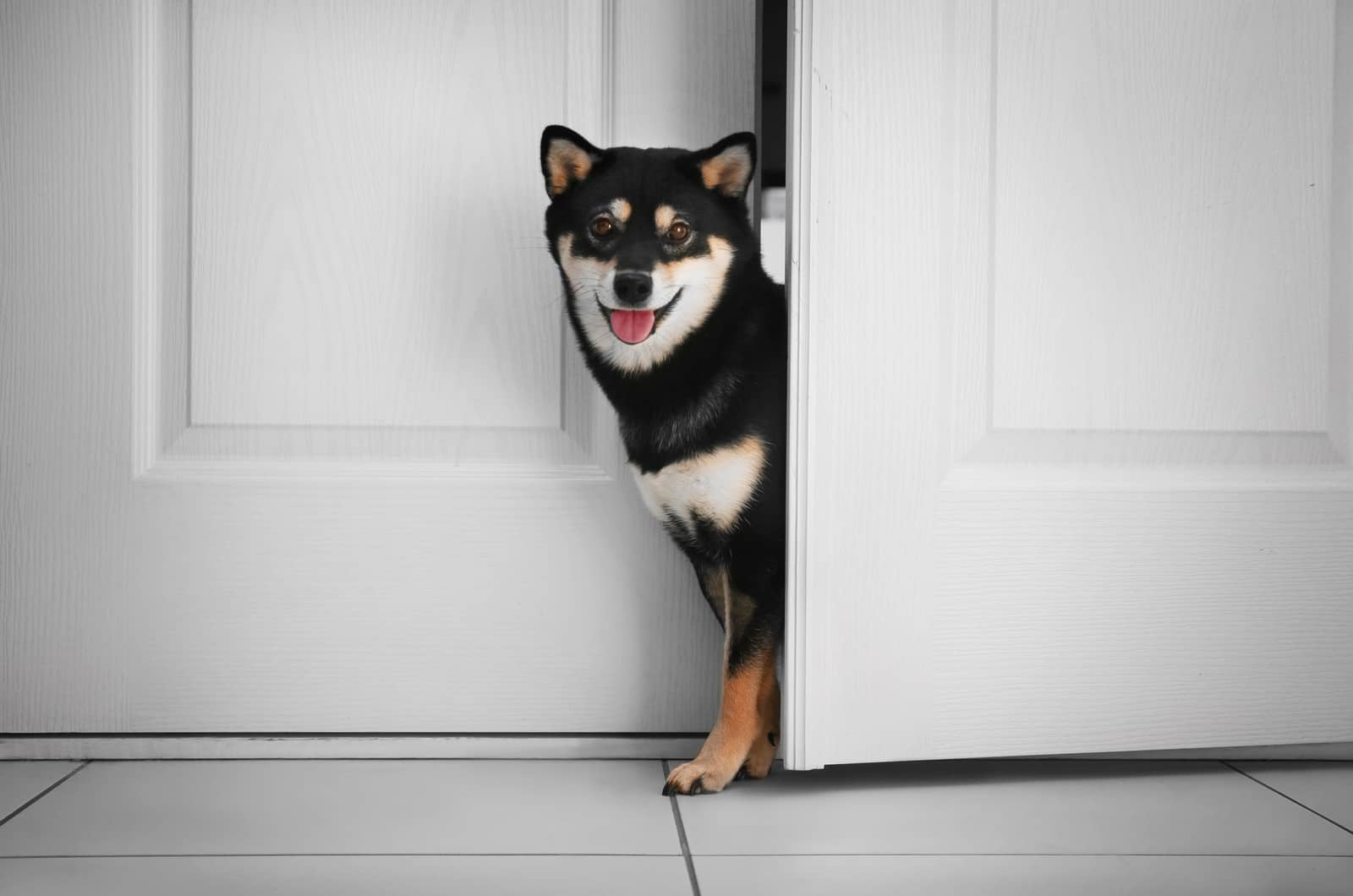
You should expect to pay between $1,400 and $3,500, which isn’t cheap.
The average price is around $2,200, which makes this one of the more expensive dogs of recent times.
Why is this?
Mostly because of supply and demand as well as the relative rarity of the breed.
Also, you may or may not recall the doge meme back in 2014 that featured a Shiba Inu (not a black one!). This raised the profile of the breed worldwide, which might have affected the price.
In more recent times, it has been linked to a cryptocurrency called Dogecoin, launched as a joke, but which seems to have been taken seriously. It’s not clear whether this will affect the price of Shiba Inu dogs, but the fact that this digital coin bears a picture of one might once again raise the Shiba’s profile!
Black Shiba Inu Puppy
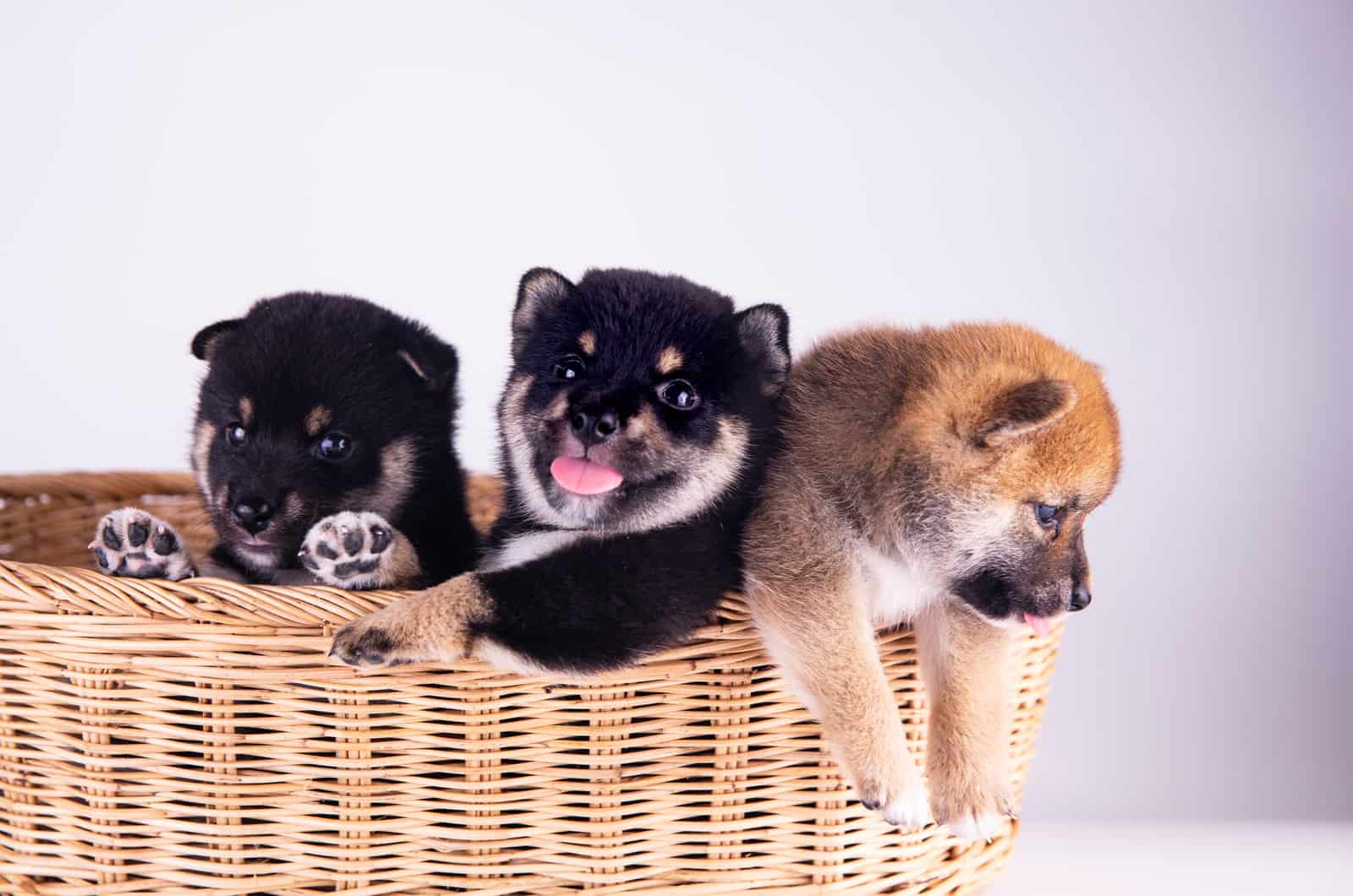
Shiba Inu puppies are very boisterous and energetic, so you’d be advised to puppy-proof your home before you get one! Make sure trailing or exposed electrical cables are hidden away. Put child locks on closets and cabinet doors, especially those containing cleaning supplies. Keep the dog food out of reach or he may help himself. If possible, set aside a quiet area for him to sleep in, and keep his bed/crate there. Buy plenty of interesting chew toys to keep him entertained – these will come in handy in the teething stage. Scan the area regularly for choking hazards, such as jewelry, coins, rubber bands, paperclips, etc. Tie up any cords on blinds to stop your pup from getting tangled in them. Remove any plants that may be poisonous to your pup, and make sure you have a secure lid on the trash can!
These are just a few issues that you need to consider.
Just like many other breeds, there’s a chance that your pup will change color as he develops. These pups often have a white blaze on their muzzle when they are born, but this tends to fade after a few weeks. Likewise, you may think you have a black sesame Shiba, but the sesame effect will often fade as the dog matures.
These color changes can take a few years to fully develop, so you won’t know the true color of your Shiba until then.
Once you have your black Shiba Inu puppy at home (okay, your black sesame/black and tan Shiba Inu), you’ll have to have your wits about you. For your own sanity and peace of mind, it’s a good idea to start his training and socialization immediately. It’s probably going to be hard work as he will think it’s a game and do the opposite of what you say. Training should be firm, consistent, and continuous as these dogs make a habit of ignoring commands.
It’s never good to leave any pup alone for a long time, and this is the case with the Shiba Inu as well. As he gets older, you should never keep him tethered in a yard, or even leave him to run free in the back yard. This is a recipe for disaster as he’ll either escape or become destructive. And, the same applies if you leave him home alone. There are horror stories out there about bored and frustrated Shiba’s who have chewed through drywall because their owners left them for too long!
It’s always best to have a contingency plan for those times when you can’t avoid leaving your doggy friend at home by themselves. You could get a trusted friend or family member to drop by for a while, or arrange for a dog sitter or dog walker to fill some of the time.
All of this highlights the fact that getting a pet is a big responsibility and should never be taken lightly.
Shiba Inu Health Problems
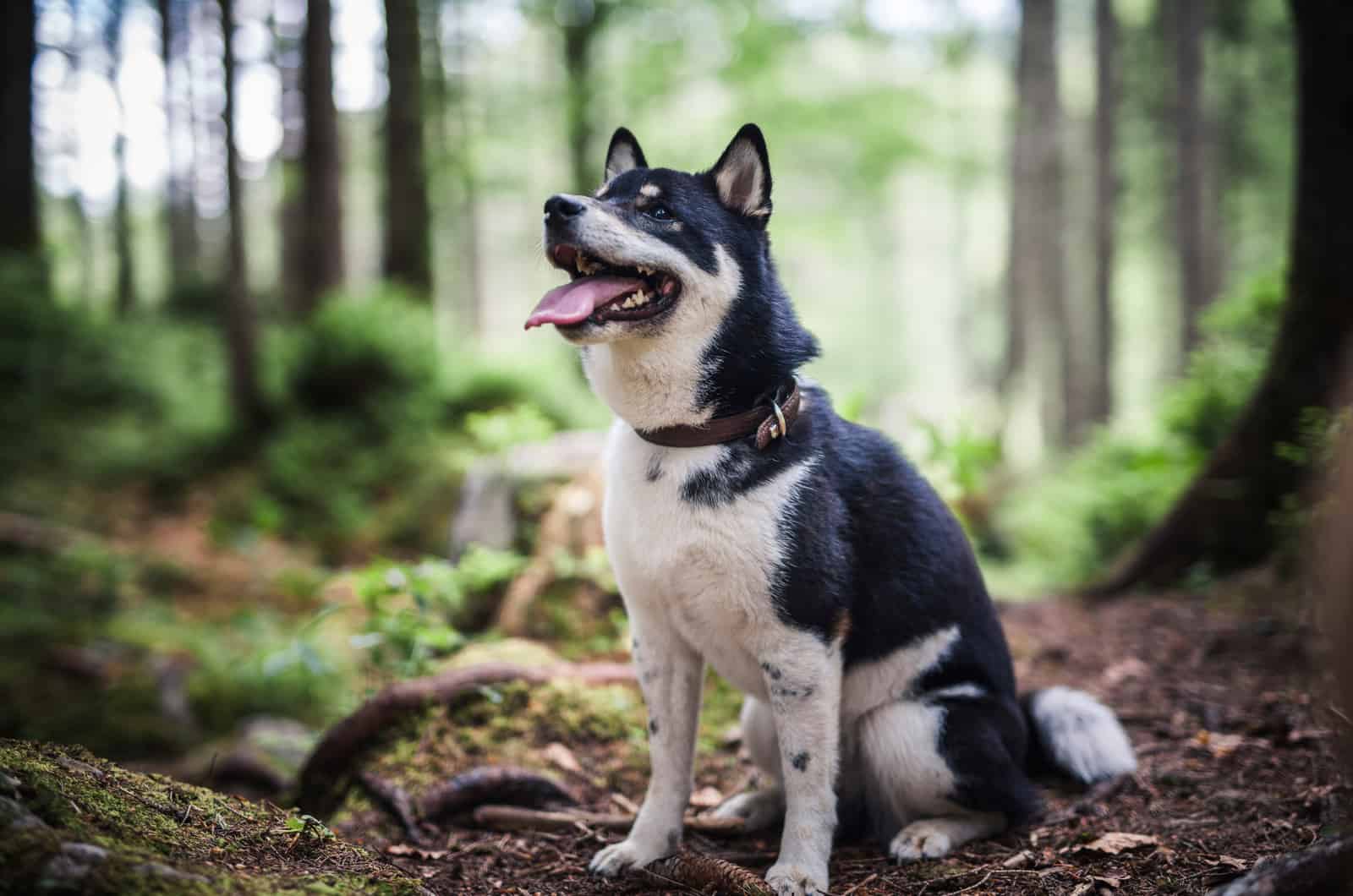
Overall, the Japanese Shiba Inu breed is pretty healthy. However, there are a few health issues to be aware of:
Hip dysplasia – A painful condition caused by a poorly formed hip joint that makes the bones rub together.
Patellar luxation – Essentially, this is a dislocated kneecap. A dog’s patellar is very small, but can sometimes slip out of place because the groove in the bone that it slides on is too shallow.
Chronic allergies – This breed is particularly prone to allergies that cause itchy skin (atopy), which often leads to skin infections.
Eye problems – Glaucoma, entropy, and Progressive Retinal Atrophy (PRA) are among the main eye problems that Shibas suffer from. Entropy is probably the least serious of these three, caused by hairs on the inside of the eyelid scraping on the cornea. The other two are more problematic, although glaucoma can usually be treated. Sadly, there is no cure for PRA at present, and the dog will eventually lose its eyesight.
The best way to reduce the risk of your pup having any of these conditions is to find a reputable breeder as they will test the parents and exclude any dog from their breeding programs if they find any sign of these diseases.
However, it is not possible to test for allergies, and pups don’t usually show any symptoms until they are at least 6 months old.
Other than this, Shibas are happy and healthy dogs, with a lifespan of between 13 and 16 years.
Why Are Shiba Inus So Aggressive?
Photo from: @kuma.the.shiba.inu
While this question might seem out of place in an article that’s supposed to be about the black Shiba Inu, it’s one that gets asked quite a lot. Also, there are many weird myths floating about the internet claiming that a dog’s coat color can affect its temperament, behavior, and character. This is particularly the case with black dogs, which is why it’s important to include a section in order to clear up any misunderstandings.
So, let’s get this straight: coat color does not affect a dog’s temperament. There is no scientific evidence to support the claim that the color of a dog’s coat shapes or influences its character or behavior in any way.
Aggression is a difficult thing to measure or identify. Many breeds have a reputation for being aggressive, although, in most cases, this is overblown or a gross misrepresentation of the facts. Few dogs are born aggressive. Some are exposed to abuse and mistreatment; others are deliberately encouraged towards aggression by bad people. Dogs can also be aggressive because they are sick or in pain.
The Shiba Inu can sometimes seem aggressive because of its independence and protectiveness. It is also strong-willed and has a high prey drive. This does not mean that it is necessarily an aggressive dog. And, with proper training and socialization, any problem in this area can be resolved.
Why Shouldn’t You Get A Shiba Inu?
It might seem an odd question, but it’s a good way of approaching the issue.
There are many reasons why you might want a particular dog breed, but it’s wise to do some research beforehand. Every breed has its own set of challenges or quirks of character, and while there might be a dozen things that make you fall in love with the Shiba Inu, there could be just as many factors that suggest that it might not be the best idea!
Here’s what you need to know:
• They have a high prey drive – With lightning reflexes and astonishing speed, they’ll chase anything that moves, including small pets.
• They’re fans of Houdini – Seriously, they’ll escape through the smallest hole in your fence and be off into the sunset before you can blink.
• They shed excessively – You might be okay with the little bit of loose hair that falls throughout the year. But, when shedding seasons arrive in spring and fall, you’ll be up to your knees in fur as they blow their thick undercoat. These dogs are seriously heavy shedders!
• They’ll scream just to shock you – If they’re upset with you or just don’t want to cooperate, they’ll make a strange scream/bark that can come as quite a shock. It’s a ploy to throw you off balance, and it nearly always works unless you’re prepared for it.
• They’re too darn clever for their own good – This dog is smart, and will look for ways to tie you in knots. You always have to be one step ahead!
• They’re possessive – Don’t touch their stuff; they don’t like it and will let you know!
They have a mischievous sense of humor – You might not find it so funny, especially as this is coupled with a stubborn streak. So, when he wants to play, he’ll play, even if you want him to do something else, such as sitting still to be groomed or have his teeth brushed.
• They can be aggressive towards other dogs – This can be compounded by the fact that it’s unwise to let them off the leash in an open, public area. Leashed dogs often show aggression (even to the surprise of their owners) as it forces dogs into an unnatural greeting position, making them feel uncomfortable and vulnerable. Shiba Inus aren’t the worst by any means, but they can make a big show of seeing other dogs off quite noisily.
• They are difficult to train – Being so strong-willed and stubborn, Shiba Inus are considered one of the worst breeds to train!
Are you up for the challenge? It takes someone with a strong personality who can provide firm, consistent training. You’ll need bags of patience, and you must stamp your authority on the relationship very early on. This needs to be kept up throughout the dog’s life.
Without this, your Shiba Inu will rule the roost and run rings around you!
A Short History Of The Shiba Inu
Photo from: @shiba_chuken.kiku.kensha
Fear not! We’re not going to launch into a dull and detailed history lesson!
But, it’s always good to have an idea about a breed’s background in order to give us a better understanding, so bear with us as we take a short detour before getting back to the black Shina Inu…
This feisty, happy dog has been around since at least 300 b.c. making it the oldest as well as the smallest Japanese dog. It was originally bred for hunting in the mountainous regions of Japan.
Shiba Inu means brushwood dog. This is thought to be a reference to the place where they usually hunted… in the mass of brushwood that covered the mountainsides. Alternatively, it may simply be because of the color of their coat as most are a rusty red color.
This is the smallest of the Japanese spitz breeds (spitz dogs are typically domestic breeds with thick fur, pointed features, and a curled tail), and is often mistaken for other native breeds such as the Akita Inu and the Hokkaido.
For around two thousand years, they were used to flush out small animals from the bushes on Japanese mountains. Following the devastation of World War II, they almost became extinct, but were saved as a breed to become the most popular companion dog in Japan today.
Despite being developed as a hunting dog, the AKC now regards the Shiba Inu breed as part of the non-sporting group.
The first Shiba Inu to arrive in America was brought over in 1954 by a family in the armed services. From that time onwards, the Shiba Inu has increased in popularity across the USA. It now sits at #44 out of the AKC’s 200 most popular dog breeds.
There, now that wasn’t too bad, was it?
What Have We Learned?
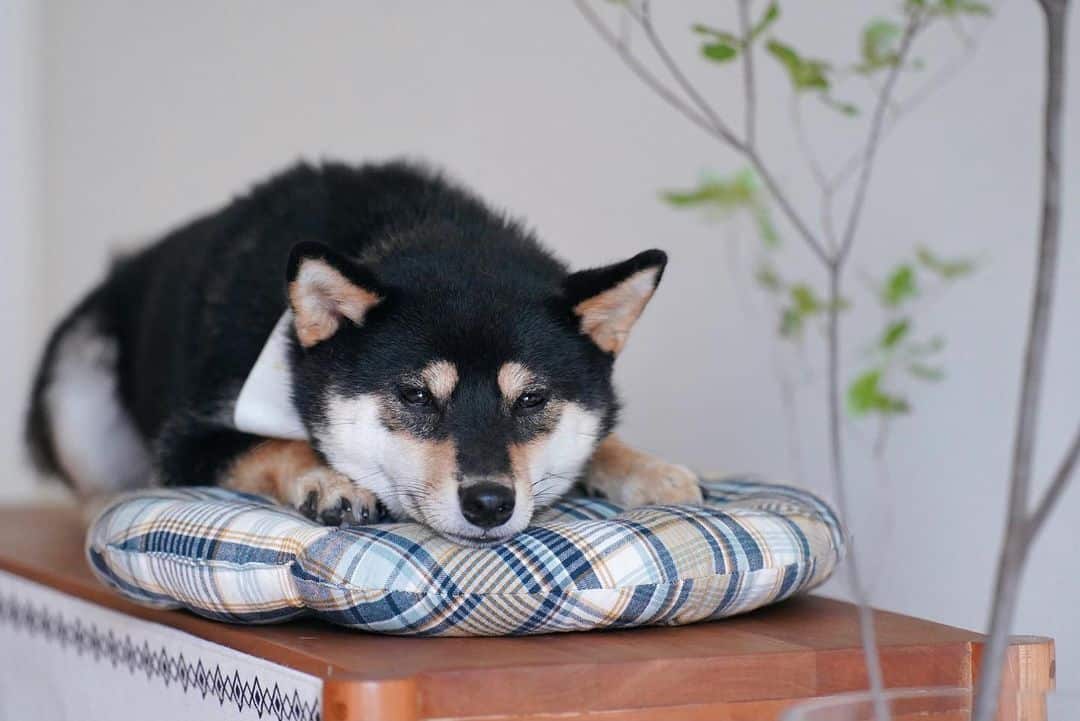
Photo from: @kuma.the.shiba.inu
About the black Shiba Inu?
We mostly learned that it isn’t real!
Hopefully, you found the rest of the information in this article helpful.
For example, we learned that it takes a dedicated, resourceful, and assertive person to successfully look after one of these dogs, whatever color you choose.
We now know that they are very affectionate, but they aren’t exactly lapdogs.
They make good watchdogs, and they can be very protective of their family and home.
You’ll have to make your home, back yard, and garden escape-proof unless you want to spend your day searching the neighborhood for your dog. A covered run is the best answer if you have the room.
Yes, they’re stubborn, willful, and mischievous. Yes, they shed heavily, and you’ll have to spend time grooming them. And yes, they are mighty difficult to train. But, if you’re an experienced dog owner, then there’s nothing here that you can’t cope with. With the right care and attention, these dogs make wonderful family pets.
However, if you’re a first-time dog owner, it might be wise to start with an easier breed.
The fact is that Shiba Inus are brilliant dogs that deserve a loving home just like any other breed. And, many of the potential problems can be overcome, or at least reduced through proper training and socialization.
By doing this, and taking precautions, you could be the right person for this dog!
